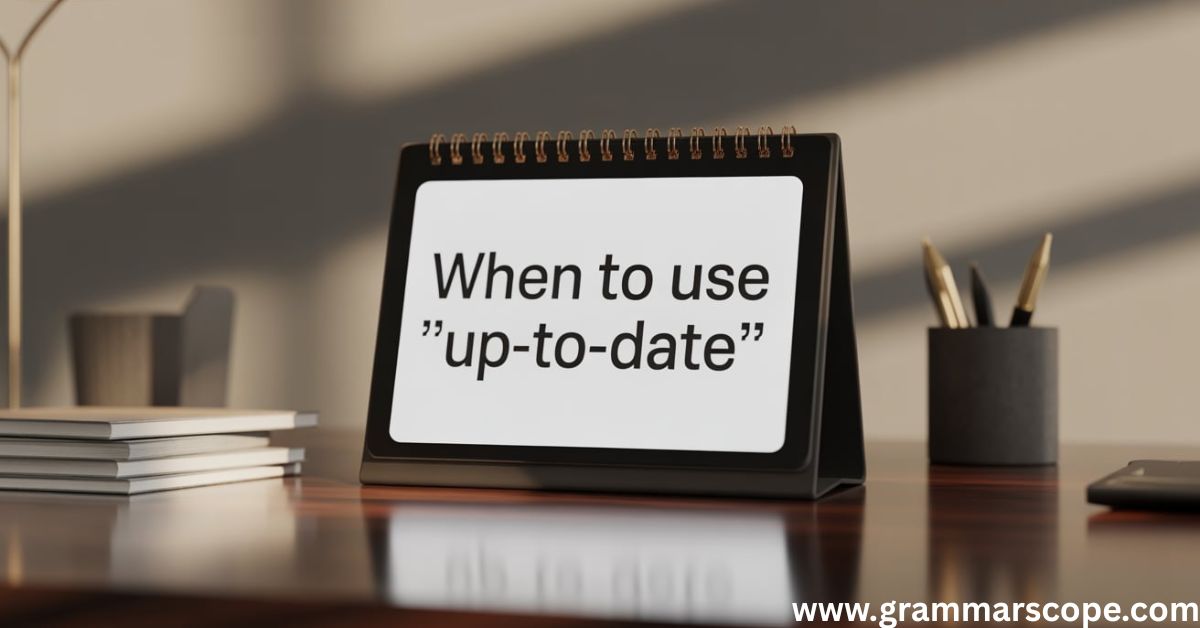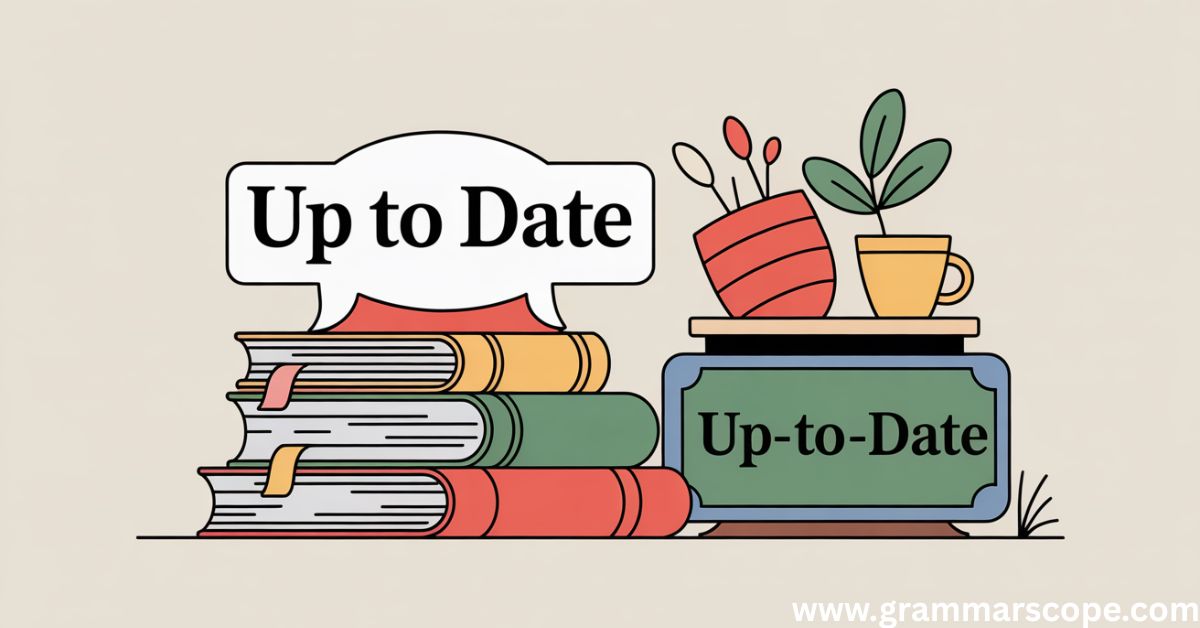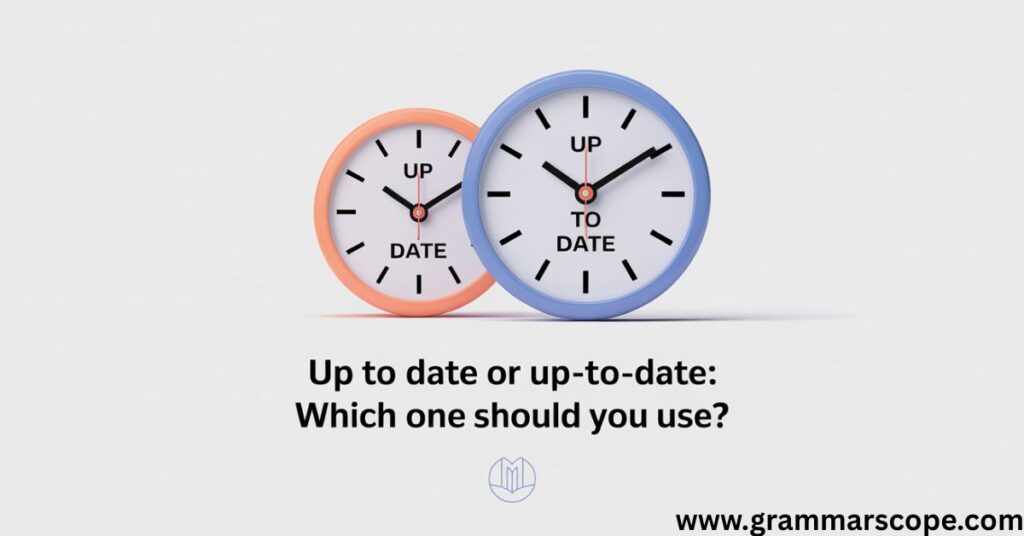Up to date or up-to-date—which one to use and when? It’s a surprisingly common English grammar confusion, especially for writers, professionals, and even native speakers. What makes things trickier is that both versions are technically correct, depending on how they’re used. If you’ve ever stared at your email draft or blog post, wondering whether to insert that tiny little hyphen, you’re not alone.
English is full of spelling confusions and tricky grammar rules, and this is one of the most subtle. The answer lies in understanding the function of the phrase in a sentence—whether it’s acting as an adjective or adverb. The presence or absence of a hyphen changes the grammar role the phrase plays.
In this article, we’ll walk through a full breakdown of when to use up-to-date and when to use up-to-date, explore scenario-based examples (like in emails), and even dive into their origins, synonyms, and proper grammar usage. By the end, you’ll not only know the correct choice—you’ll never second-guess it again.
What Does “Up to Date” Mean?
The phrase “up to date” is commonly used as an adverbial phrase, meaning it modifies verbs and describes an action. In this form, it’s not hyphenated.
📧 Email Example (Adverb Use):
“Hi Lisa, I wanted to make sure the software is up to date before the launch.”
In this sentence, “up to date” is describing the state of being current, and it modifies the verb is—no hyphen needed.
So, if you’re talking about something being current, modern, or updated, and you’re using it after a verb, you’re safe to use the non-hyphenated version.
What Does “Up-to-Date” Mean?
When “up-to-date” is used before a noun, it functions as a compound adjective. This is when the hyphen comes into play.
📧 Email Example (Adjective Use):
“Please send me the most up-to-date marketing brochure by Friday.”
Here, “up-to-date” modifies the noun brochure, and we use the hyphen to tie the words together into a single descriptor.
Pro Tip: Compound adjectives like this often need hyphens to avoid confusion and improve clarity. Always hyphenate “up-to-date” when it directly describes a noun.
“Up to Date” vs “Up-to-Date”
So, is it up-to-date hyphenated? That depends entirely on context.
| Usage Type | Example | Hyphenated? |
|---|---|---|
| As Adverb | The database is up to date. | No |
| As Adjective | We need an up-to-date database. | Yes |
Grammar rules up to date require that you add the hyphen only when the phrase acts as a compound adjective before a noun.
When to Use “Up to Date”
Use “up to date” when it’s:
- After a linking verb (is, are, was, etc.)
- Describing a condition or state
- Not directly modifying a noun
🧾 Example:
“Our records are up to date, thanks to the new tracking system.”
You’ll often find this version in technical documentation, progress reports, or status updates.
When to Use “Up-to-Date”

Use “up-to-date” when:
- Before a noun
- Used as a compound adjective
- You want to emphasize modernity or recency
🧾 Example:
“She gave an up-to-date analysis of the market trends.”
This version is widely used in media, business writing, and creative content, where concise clarity is essential.
The Importance of Context
Context is king. That tiny hyphen in “up-to-date” does more than add a dash—it signals the phrase’s role in the sentence.
Rule of Thumb:
Adjective (before a noun) = Hyphenated
Adverb (after a verb) = Not hyphenated
If you’re unsure, try to replace the phrase with “modern” or “current.” If the sentence still makes sense, it’s probably an adjective, so hyphenate.
Synonyms for “Up to Date” and “Up-to-Date”
Variety keeps writing fresh. Here are some useful synonyms to diversify your language:
Synonyms for “Up to Date” (Adverbial Phrase)
- Current
- Modern
- Updated
- Informed
- On top of things
📧 Email Example:
“Our team is on top of things with all security protocols.”
Synonyms for “Up-to-Date” (Adjective Phrase)
- Contemporary
- Latest
- Newest
- Cutting-edge
- Trendy
📧 Email Example:
“I’m attaching the latest product catalog.”
(Here, “latest” replaces “up-to-date.”)
Choosing the Right Synonym
Be careful when swapping phrases. While synonyms help with variety, they may not fit every tone or context. For instance, “cutting-edge” might sound too informal or trendy for legal documents.
🎯 Pro Tip: Always reread your sentence after replacing a phrase to ensure the meaning and tone remain intact.
Examples in Context
Let’s dive deeper into the correct usage of up-to-date in real-world examples.
Examples Using “Up to Date” (Adverbial Phrase)
- “The curriculum is now fully up to date after the latest revision.”
- “Are your antivirus definitions up to date?”
- “Let’s keep the client up to date with our progress.”
These examples show no hyphen because the phrase modifies the verb or action.
Examples Using “Up-to-Date” (Adjective Phrase)
- “We offer up-to-date tech solutions for startups.”
- “He owns an up-to-date model of the Tesla.”
- “This is the most up-to-date policy on social media compliance.”
Notice how each phrase directly modifies a noun, requiring the hyphen.
Origins of “Up to Date” and “Up-to-Date”

The phrase “up to date” originated in the late 19th century, initially about financial records. Being “up to date” meant your books were current—not lagging.
Over time, the term evolved, especially during the tech boom, to include software, fashion, and knowledge. The hyphenated version became more common as compound adjectives grew in modern usage.
This evolution reflects a broader trend in English compound formation, especially where clarity and brevity are key.
Conclusion
So, to answer the core question: “Up to date or up-to-date— which one should you use?”
- Use “up-to-date” before a noun → adjective → hyphenated
- Use “up to date” after a verb → adverb → no hyphen
Now that you understand the difference between up-to-date and up-to-date, you can write with clarity, confidence, and a stronger grasp of proper grammar usage.
The next time you draft an email, publish a blog post, or polish a resume, you’ll know exactly which form to use—and why it matters.

Emma Olivia is an experienced blogger and the creative mind behind Grammar Scope. With a passion for language and years of writing expertise, she crafts engaging, informative content that simplifies grammar and writing tips for readers worldwide. Emma’s dedication to clear communication and love for the written word shine through every article she publishes, making Grammar Scope a trusted resource for language enthusiasts and learners alike.







